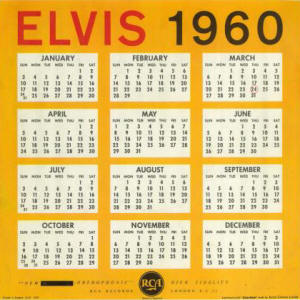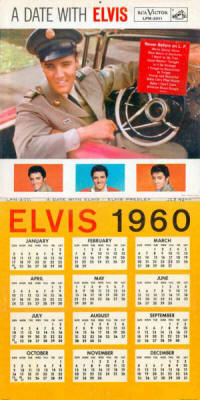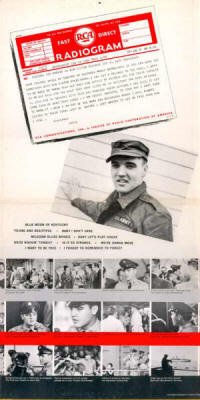Verdict
Once again RCA compiled a good album of hard to get SUN recordings and lesser known tracks from more recent eps. It's an attractive package, but not as strong as "For LP Fans Only".
![]()
(C) RCA Records
The ultimate site about the king of the analogue age




With Elvis still serving his country in Germany and being unwilling to record anything new, RCA Victor had no choice but to issue another compilation of already released material. "A Date With Elvis" hit the stores on July 24, 1959 and sold 170,000 units. On September 21st Billboard started to list the longplayer on their "Pop Albums Chart". It had a run of eight weeks and peaked at number 32. In Great Britain the record was much more successful and reached number 4. Worldwide RCA sold two million copies, which equals 300 million paid streams of the complete album or 3 billion paid streams of individual tracks. Therefore "A Date With Elvis" couldn't compete with the kings albums released prior to 1959, but sold significantly better than "For LP Fans Only".
In 2016 the complete Presley catalogue was restored and remastered by Vic Anesini for a boxed set of 60 compact discs called "The Album Collection". Sony Music Entertainment provides the streaming platforms with the same versions of the individual albums (some of them offering bonus tracks), albeit in 24 bit/90 khz flac. That means, if the platform of your choice supports high resolution audio, you can enjoy the tracks in the same quality Sony used to scan and master them. On Spotify, which has a market share of approximately 30% and is the only platform that publishes streaming figures, "A Date With Elvis" accumulates 250 million streams and is requested 70,000 times per day. So today the previously released "For LP Fans Only" is twice as popular as "A Date With Elvis".
One of the reasons for the success of the vinyl record might have been the elaborate packaging. The longplayer was housed in a fold out cover, that could be hung on the wall. Elvis was shown wearing a neat uniform, sitting in his famous pink Cadillac and ready to pick up his lady for a date. The sleeve also featured a calendar of 1960, on which Elvis' supposed release date from the US Army was marked. The first edition of "A Date With Elvis" didn't include a track list. Later it was added on a sticker, then the "sticker" was printed on the cover.
RCA Victor stuck to the principle of "For LP Fans Only" and compiled material, that hadn't been released on a longplayer yet. Many people had become fans through hits like "All Shook Up" or "Teddy Bear" and therefore didn't know the early recordings of their idol. Remember, back in those days there was no streaming and no online shopping, so you could only buy, what was offered in the local stores. And that was mostly the new stuff. Just like "For LP Fans Only" this longplayer didn't play all that long. It had a running time of just 22:58 minutes.
In 2017 Follow That Dream Records released a collector's edition of "A Date With Elvis", which also included bonus songs, outtakes and home recordings from Germany. For a review just tap HERE.
Blue Moon Of Kentucky
On July 7, 1954 the group returned to SUN Records to produce a b-side for "That's All Right", their first single. They selected "Blue Moon Of Kentucky", a song by Bill Monroe, who recorded it in 1946. In general they used the same procedure. The song was played faster and performed in the newly developed Presley style. RCA Victor released "Blue Moon Of Kentucky" on the album "The Sun Sessions" (1976) as well as on the extended player "A Touch Of Gold - Volume 3" (1960).
Young And BeautifulThis one was known from the movie "Jailhouse Rock" and had also been released on the accordant soundtrack ep. In 1971 RCA would re-release the track on the boxed set "The Other Sides - Worldwide Gold Award Hits Volume 2". The ballad was written by Abner Silver and Aaron Schroeder and was recorded by Elvis on April 30, 1957. It wasn't an easy task for him, because he needed 22 attempts to get it right. I like "Young And Beautiful", but I am pretty sure, that the king would have sung it better in his later years.
(You're So Square) Baby I Don't CareHere we have another song from "Jailhouse Rock". Because Bill Black couldn't get his bass-part right, he stormed out of the studio and left the baffled crew behind. To everyone's surprise Elvis took the bass and played the part himself. It worked well, but his vocals were unsatisfactory. So the recording from May 3, 1957 was just used as a rhythm track. Five days later Elvis sang to the pre-recorded music, the master was a combination of the takes 16 (music) and 6 (vocals). "(You're So Square) Baby I Don't Care" was written by Jerry Leiber and Mike Stoller and released on the extended player "Jailhouse Rock".
Milkcow Blues BoogieOriginally the song was named "Milkcow Blues" and was written and recorded by Kokomo Arnold in 1939. Elvis, Scotty and Bill played the song faster and used the by now established style of the Hillbilly Cat. To make it short: I don't like the tune at all. The "Milkcow Blues Boogie" first appeared on the a-side of Elvis' third SUN single, RCA later re-released it on the album "The Sun Sessions" (1976).
Baby Let's Play HouseThe song was written by Arthur Gunther, who released it in 1954. Elvis followed him sometime between January 30, 1955 and February 4, 1955. He recorded two takes of "Baby Let's Play House", the first one was selected as master. In contrast to Gunther the king started his performance with the chorus and changed the line "...you may give religion, baby" to "...you may have a pink Cadillac". He alluded to his choice of transportation, which today is regarded to be an icon of the 1950's. Back then the paraphrase "to play house" meant to play familylife by children. But the teenagers used the phrase to describe a well-defined part of the family life: The production process of children. So it's quite obvious what the singer means, when he invites his lady to "play house". For me, this bold song is nothing but great. It was the a-side of the king's fourth SUN single and the first of his releases, that gained national interest. On Billboard's country charts it peaked at the numbers 5 (Most Played By Jockeys) and 10 (Best Sellers In Stores). Of course it was also used by RCA on the compilation "The Sun Sessions" (1976).
Good Rockin' TonightThe singer asks a girl out for dancing, but the subtext clarifies, that dancing isn't the only thing he wants to do with the lady. "Good Rockin' Tonight" was written by Roy Brown, who also recorded it in 1947. Elvis followed him on September 10, 1954 at SUN Records in Memphis/Tennessee. The track was released on the a-side of his second single, which didn't sell as well as the first one. Five years later, RCA Victor re-released the track on the extended player "A Touch Of Gold - Volume 1". In 1976 "Good Rockin' Tonight" was also included on the album "The Sun Sessions". For me, this is one of the king's best SUN recordings.
Is It So StrangeThis one was known from the extended player "Just For You". Elvis taped Faron Young's "Is It So Strange" on January 19, 1957 within 12 takes. On the same day Steve Sholes also recorded harmony vocals, which were added to the master take. I neither like the song, nor Elvis' performance.
We're Gonna MoveThis track is based on the traditional "There's A Leak In This Old Building", the master is a splice of the takes 4 and 9, as recorded on August 24, 1956. On the same day harmony vocals, hand clapping and finger snapping were taped. Here the takes 2 and 1 were used. In the end it was decided to do without the harmony vocals. Originally "We're Gonna Move" was released on the "Love Me Tender" soundtrack, in 1971 it was also included on the boxed set "The Other Sides - Worldwide Gold Award Hits Volume 2".
I Want To Be FreeNow the album returns to the soundtrack of "Jailhouse Rock". "I Want To Be Free" was written by Jerry Leiber and Mike Stoller and taped by Elvis on May 3, 1957. First he recorded 11 takes, after that two additional pick up-takes of the songs' finale were produced. Further the king recorded five pick up-takes of an alternate finale. For the master take Jeffrey Alexander (the producer of the sessions) used take 11 and pickup-take 5 (alternate finale).
I Forgot To Remember To ForgetThe song was written by Stan Kesler and Charlie Feathers, who also recorded it for SUN, but the track remained unreleased at the time. "I Forgot To Remember To Forget" was a part of Elvis' stage repertoire and he had sung it several times on the radio show "The Louisiana Hayride". He finally recorded it on July 21, 1955 and added the drummer Johnny Bernero to his group. Even though it was just the b-side of "Mystery Train", it became more popular and peaked at the numbers 4 (Most Played By Jockeys) and 1 (Most Played In Jukeboxes & Best Seller In Stores) of the country charts. RCA re-released the track on the extended player "Heartbreak Hotel" (1956) and the album "The Sun Sessions" (1976).
Once again RCA compiled a good album of hard to get SUN recordings and lesser known tracks from more recent eps. It's an attractive package, but not as strong as "For LP Fans Only".
![]()
(C) RCA Records